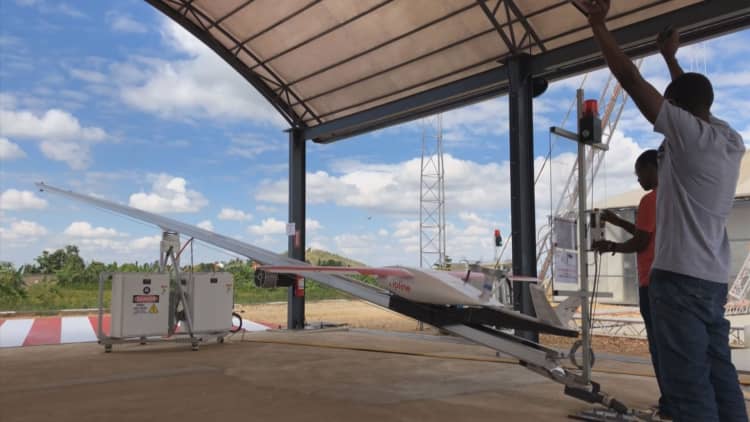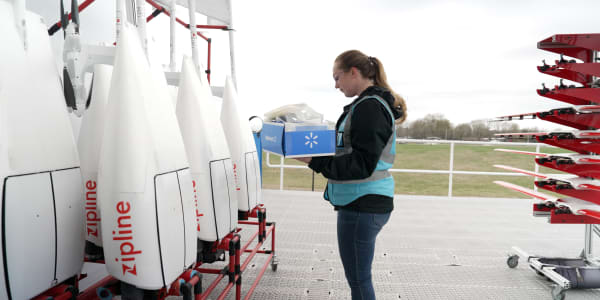In an emergency medical situation, timing can be the difference between life and death. In areas where delivering essential medical supplies can be difficult, the Department of Defense is looking for better options. A just-completed series of military exercises tested whether drones provide a solution.
Drone company Zipline partnered with the DoD and Naval Medical Research Center to deploy its drones during four multinational military forces exercises in Australia between July 30 and Sept. 5. Zipline made more than 400 deliveries, including mock blood resupplies to shock trauma platoons.
Zipline CEO Keller Rinaudo said the Department of Defense's innovation unit came to the drone company because of its success transporting medical supplies in Rwanda and Ghana. Their shared goal of delivering critical medical supplies in a more efficient manner was the driving force behind the team-up.
The company's drones are particularly good for delivering these supplies because of the added range from their fixed wing design. Unlike quadrocopter drones, Zipline's drones look like a miniature plane, and are launched from a catapult of sorts.
That design was first put to the test by the DoD in a 79-mile round trip delivery flight at an average speed of 64 miles per hour, the longest drone delivery in U.S. history, which was conducted in Oct. 2018, before the military exercises in Australia.
Zipline announced its partnership with the Department of Defense on Tuesday.
The Zipline drones were required to simultaneously respond to emergency delivery requests from three different locations simulating mass-casualty events, and deliver 150 lbs of cargo in under three hours. The drones were also tested in extreme conditions, like 30 mile-per-hour winds, hard rain, darkness, zero-visibility fog and artillery fire.
One factor the drones are not expected to face is anti-aircraft fire.
"These vehicles are flying 60 to 70 mph and 400 to 500 feet in the air, and we won't be operating in a context where someone will have anti-aircraft weaponry," Rinaudo said. "The shell would cost more than the plane."
Drone challenges in conflict zones
Some questions do remain about use of the drones on the battlefield. Rand Institute senior operations researcher Brent Thomas says that Zipline could have issues integrating into an extremely heavy-conflict environment.
"The security requirements might not quite fit in with where the DoD would be willing to send civilians for contracts," Thomas said, explaining that if depots for blood, blood products and medical supplies are too close to the forward lines of action, "maybe that's not the place we want to send contractors."
The Rand researcher also worries about hacking risk with autonomous drones on the modern battlefield, such as the drones being sent somewhere they aren't needed. Zipline does use military-grade encryption and says the DoD is up to speed on all of its safety and security capabilities.
The biggest issue for drones on the battlefield may be flying at the same time as other major aircraft, according to Thomas.
"If I'm going to have lots of drones, lots of other assets in the air — say helicopters or other low-flying aircraft — it can be very difficult to maintain that situational awareness of where all aircraft are at all times," Thomas said. "So deconflicting that airspace to make sure that nobody runs into each other at worst, that's probably the biggest challenge."

But the disaster relief applications for drones in the military are promising.
"The DoD does frequently support supply missions," Thomas said. "That would be in a natural disaster context. Say a typhoon has just hit in the Philippines or the National Guard needs to support natural disaster recovery close by the Caribbean and Haiti or at home in the wake of another Katrina-like event. I think that is another space where Zipline could offer that resupply capability."
Rinaudo said that Zipline's mission hasn't changed.
"For the foreseeable future, all Zipline is going to do is health-care logistics, because people need it," Rinaudo said. "People care about it; people know the value. We have focused all of our efforts on disaster response and health care."
Thomas thinks long-range blood deliveries are not far off, and he expects them to be done routinely by 2025.
"Zipline is really helping to kick in the door there to help understand what the challenges would be of scaling up those operations," he said. "So they're definitely leading the charge. It's fascinating to watch the evolution of it.
Rinaudo says Zipline is planning to do five times as many drone flights with the Department of Defense's Defense Innovation Unit next year.
Correction: Zipline drones used in Department of Defense testing fly at an elevation of 400 to 500 feet.






